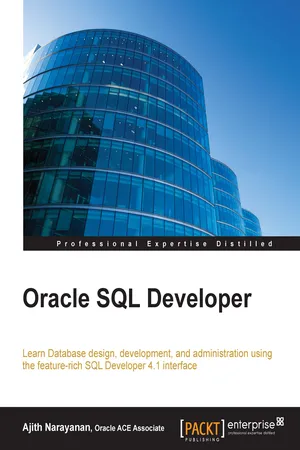
- 344 pages
- English
- ePUB (mobile friendly)
- Available on iOS & Android
Oracle SQL Developer
About This Book
Learn Database design, development, and administration using the feature-rich SQL Developer 4.1 interface
About This Book
- Explore all the SQL Developer 4.1 features useful for Oracle database developers, architects, and administrators
- Understand how this free tool from Oracle has evolved over the years and has become a complete tool that makes life easy for Oracle and third-party database users
- The author, Ajith Narayanan, has a total of 10+ years of work experience as an Oracle [APPS] DBA
Who This Book Is For
This book is intended for Oracle developers who are responsible for database management. You are expected to have programming knowledge of SQL and PL/SQL, and must be familiar with basic Oracle database concepts.
What You Will Learn
- Install and navigate through all the advanced features of SQL Developer that were introduced in version 4.1
- Browse, create, edit, and delete (drop) database objects
- Use the SQL worksheet to run SQL statements and scripts, edit and debug PL/SQL code, manipulate and export (unload) data
- Carry out all DBA-related activities such as exporting/importing, tuning, and analyzing database performance issues
- Quickly analyze, create, and edit the data model using data modeler
- Extend the SQL developer capabilities by exploring the APEX related pages, enabling and working with RESTful services
- Use the available reports and create new custom reports with custom scripts
- Grasp how to connect to third-party databases and work smoothly with them
In Detail
At times, DBAs support 100s of databases at work. In such scenarios, using a command-line tool like putty adds to the difficulty, while SQL Developer makes the life of a developer, DBA, or DB architect easier by providing a graphical user interface equipped with features that can bolster and enhance the user experience and boost efficiency. Features such as DBA panel, Reports, Data Modeler, and Data Miner are just a few examples of its rich features, and its support for APEX, REST Services, timesten, and third-party database drivers demonstrate its extensibility.
You may be a newbie to databases or a seasoned database expert, either way this book will help you understand the database structure and the different types of objects that organize enterprise data in an efficient manner. This book introduces the features of the SQL Developer 4.1 tool in an incremental fashion, starting with installing them, making the database connections, and using the different panels. By sequentially walking through the steps in each chapter, you will quickly master SQL Developer 4.1.
Style and approach
This book follows a step-by-step approach and is in a conversational and easy-to-follow style. Screenshots, and detailed explanations of the basic and advanced features of SQL Developer 4.1 that will make your work and life easy.
Frequently asked questions
Information
Oracle SQL Developer
Table of Contents
Table of contents
- Oracle SQL Developer